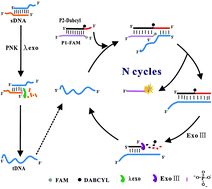The phosphorylation of nucleic acids with 5′-hydroxyl termini catalyzed by polynucleotide kinase (PNK) plays a critical role in numerous cellular activities, including DNA recombination, DNA replication and DNA repair, during strand damage and interruption. The evolution of polynucleotide kinase activity and inhibition has attracted considerable attention in recent years. Here, we describe a new method that combines a coupled λ exonuclease reaction and exonuclease III-aided fluorescence signal amplification for PNK activity and inhibition detection. By recycling trigger DNA and continuously liberating the fluorescence probe for signal amplification, the strategy can be used for the simple and accurate determination of polynucleotide kinase (PNK) activity. Moreover, the inhibition effect of adenosine diphosphate on T4 PNK activity has also been investigated. The strategy also performs well in complex biological samples. This method not only offers a new opportunity for DNA phosphorylation-related process evolution, but also holds a great potential to apply in detection of other end-processing enzymes and biomolecular diagnosis.
